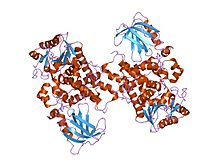Myotubularin
Appearance
| Myotubularin-related | |||||||||||
|---|---|---|---|---|---|---|---|---|---|---|---|
 Structure of a phosphoinositide phosphatase.[1] | |||||||||||
| Identifiers | |||||||||||
| Symbol | Myotub-related | ||||||||||
| Pfam | PF06602 | ||||||||||
| InterPro | IPR010569 | ||||||||||
| SCOP2 | 1m7r / SCOPe / SUPFAM | ||||||||||
| OPM protein | 1zvr | ||||||||||
| |||||||||||
Myotubularin domain represents a region within eukaryotic myotubularin-related proteins that is sometimes found with the GRAM domain InterPro: IPR004182. Myotubularin is a dual-specific lipid phosphatase that dephosphorylates phosphatidylinositol 3-phosphate and phosphatidylinositol (3,5)-bi-phosphate.[2] Mutations in gene encoding myotubularin-related proteins have been associated with disease.[3]
Human proteins containing this domain
MTM1; MTMR1; MTMR10; MTMR11; MTMR12; MTMR2; MTMR3; MTMR4; MTMR6; MTMR7; MTMR8; MTMR9; SBF1; SBF2;
References
- ^ Begley MJ, Taylor GS, Kim SA, Veine DM, Dixon JE, Stuckey JA (December 2003). "Crystal structure of a phosphoinositide phosphatase, MTMR2: insights into myotubular myopathy and Charcot-Marie-Tooth syndrome". Mol. Cell. 12 (6): 1391–402. doi:10.1016/S1097-2765(03)00486-6. PMID 14690594.
- ^ Majerus PW, Nandurkar HH, Layton M, Laporte J, Selan C, Corcoran L, Caldwell KK, Mochizuki Y, Mitchell CA (2003). "Identification of myotubularin as the lipid phosphatase catalytic subunit associated with the 3-phosphatase adapter protein, 3-PAP". Proc. Natl. Acad. Sci. U.S.A. 100 (15): 8660–8665. doi:10.1073/pnas.1033097100. PMC 166368. PMID 12847286.
- ^ Suter U, Berger P, Bonneick S, Willi S, Wymann M (2002). "Loss of phosphatase activity in myotubularin-related protein 2 is associated with Charcot-Marie-Tooth disease type 4B1". Hum. Mol. Genet. 11 (13): 1569–1579. doi:10.1093/hmg/11.13.1569. PMID 12045210.
